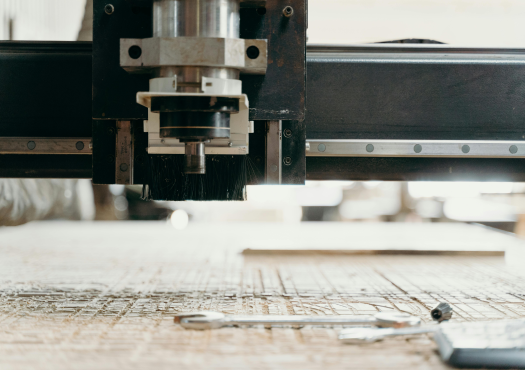The links below are affiliate links. This means every time you purchase through these links, I earn a small commission.
Navigating the wide range of CNC router bits can be daunting, especially for someone just starting. While there are many more bit-types than I’ve explained in this post, this is a great place to start! As a beginner in the CNC world, I remember spending countless hours trying to decipher the differences between Ball Nose, Up-Cut, Down-Cut, Compression, and V-Groove Bits. Understanding when to use each one felt like an impossible task. But don’t worry, through trial and tribulation, I’ve created this guide for you. Let’s jump right in.
End Mill Bits

End Mill Bits are bits designed to plunge into or clear material out of your piece. Whether you’re looking to cut out shapes, or letters, create pockets or even clear a majority of material out of a piece before engraving detail, this bit is a very common choice.
Surfacing Bits

Surfacing Bits are widely known to flatten or plane a surface. Whether you want to make sure that your spoil board is perfectly flat or planing a piece that is not smooth and flat to begin with, this type of bit will help you accomplish just that.
Engraving & V-Groove Bits

Engraving and V-Groove Bits are similar in that they are used to engrave intricate designs in your piece. They are tapered to a point to create a bit that can carve out details.
Engraving Bits are used to engrave fine details into a piece, they excel at fine detail work, fine lines, fine grooves and shaping 3D pieces. They can be purchased at 30°, 45°, 60° or 90°.
V-Groove Bits are heavily used in sign-making. They make a beautiful V-shaped groove that helps to improve the visibility of letters or numbers on a sign. They are also used for chamfering edges and cleaning up unsightly rough edges. They are available at 30°, 60° and 90°.
*The higher the angle, the deeper the groove.
Up-Cut, Down-Cut And Compression Spiral Bits
An Up-Cut Bit will pull material(woodchips) up and away from your piece. It’s recommended to use this type of spiral bit if you need the bottom side of your piece to have clean cuts or if you are cutting deep cuts. This bit can lead to fraying or tear out on the top surface of your piece.
A Down-Cut Bit will push the material(woodchips) down into the piece leaving the top surfacing with the cleaner cut. It is recommended to have a vacuum or air compressor at the ready to keep your cuts from becoming compacted with woodchips.
A Compression Bit is a combination of a Down-Cut and Up-Cut bit that allows both the top and bottom surfaces of your piece to have clean cuts. This bit is commonly used when cutting into plywood however, when using a Compression bit you have to be sure that the cut depth is below the area on the bit that changes from Up-Cut to Down-Cut or you will have the same results that you would with an Up-Cut bit.
2 Flutes, 3 Flutes, What’s the Difference?
Flutes are characterized as sharp slots that travel along the bit allowing material to evacuate from the wood piece.

A 2 Flute Bit is used when more material clearing is needed, they succeed at clearing wood chips out of the way during milling. However, they have a bit less of a clean finish and are ideal for roughing. This bit is also preferred for softwoods due to its ability to clear material out of the way.
A 3 Flute has smaller flutes which will cause some of the chips to potentially stick to your bit while milling, causing your bit to overheat. It’s recommended to use a 3 Flute bit if you want cleaner roughing when milling hardwoods.
Ball Nose Bit
Ball Nose Bits are round-tipped bits used to create grooves and gradual slopes. The area commonly used when milling the juice groove in a cutting board.
A Tapered Ball Nose Bit is similar to a Ball Nose Bit in that it has a round tip however, the bit itself tapers to a point. These bits are widely used for 3D carving and small details as they can create smooth surfaces and fine details.

